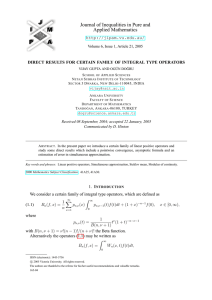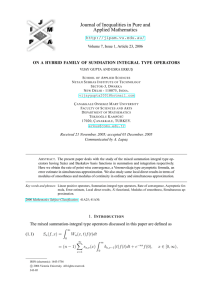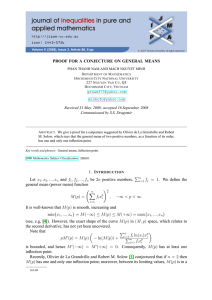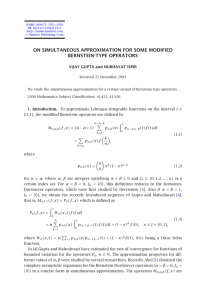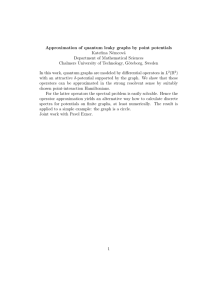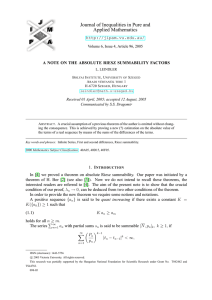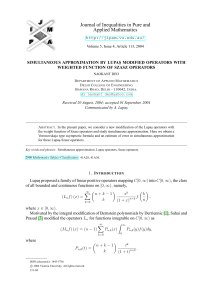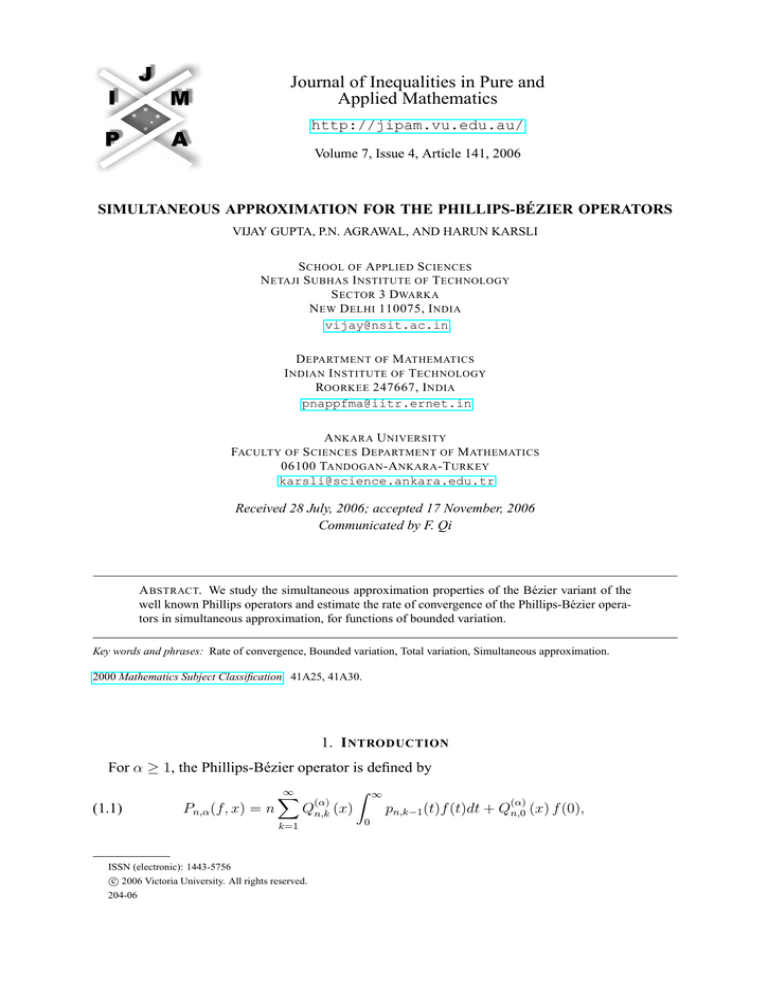
Journal of Inequalities in Pure and
Applied Mathematics
http://jipam.vu.edu.au/
Volume 7, Issue 4, Article 141, 2006
SIMULTANEOUS APPROXIMATION FOR THE PHILLIPS-BÉZIER OPERATORS
VIJAY GUPTA, P.N. AGRAWAL, AND HARUN KARSLI
S CHOOL OF A PPLIED S CIENCES
N ETAJI S UBHAS I NSTITUTE OF T ECHNOLOGY
S ECTOR 3 DWARKA
N EW D ELHI 110075, I NDIA
vijay@nsit.ac.in
D EPARTMENT OF M ATHEMATICS
I NDIAN I NSTITUTE OF T ECHNOLOGY
ROORKEE 247667, I NDIA
pnappfma@iitr.ernet.in
A NKARA U NIVERSITY
FACULTY OF S CIENCES D EPARTMENT OF M ATHEMATICS
06100 TANDOGAN -A NKARA -T URKEY
karsli@science.ankara.edu.tr
Received 28 July, 2006; accepted 17 November, 2006
Communicated by F. Qi
A BSTRACT. We study the simultaneous approximation properties of the Bézier variant of the
well known Phillips operators and estimate the rate of convergence of the Phillips-Bézier operators in simultaneous approximation, for functions of bounded variation.
Key words and phrases: Rate of convergence, Bounded variation, Total variation, Simultaneous approximation.
2000 Mathematics Subject Classification. 41A25, 41A30.
1. I NTRODUCTION
For α ≥ 1, the Phillips-Bézier operator is defined by
(1.1)
Pn,α (f, x) = n
∞
X
(α)
Qn,k
k=1
ISSN (electronic): 1443-5756
c 2006 Victoria University. All rights reserved.
204-06
Z
(x)
∞
(α)
pn,k−1 (t)f (t)dt + Qn,0 (x) f (0),
0
2
V IJAY G UPTA , P.N. AGRAWAL ,
AND
H ARUN K ARSLI
where n ∈ N, x ∈ [0, ∞),
(α)
Qn,k
α
α
(x) = [Jn,k (x)] − [Jn,k+1 (x)] ,
Jn,k (x) =
∞
X
pn,j (x)
and
j=k
k
−nx (nx)
pn,k (x) = e
.
k!
For α = 1, the operator (1.1) reduces to the Phillips operator [1]. Some approximation properties of the Phillips operators were recently studied by Finta and Gupta [2]. The rates of convergence in ordinary and simultaneous approximations on functions of bounded variation for the
Phillips operators were estimated in [3], [4] and [5]. In the present paper we extend the earlier
study and here we investigate and estimate the rate of convergence for the Bézier variant of the
Phillips operators in simultaneous approximations by means of the decomposition technique of
functions of bounded variation. We denote the class Br,β by
n
(r)
Br,β = f : f (r−1) ∈ C[0, ∞), f± (x) exist everywhere and are bounded on every
o
(r)
finite subinterval of [0, ∞) and f± (x) = O(eβt ) (t → ∞), for some β > 0 ,
(0)
r = 1, 2, . . . . By f± (x) we mean f (x±). Our main theorem is stated as:
Theorem 1.1. Let f ∈ Br,β , r = 1, 2, ... and β > 0. Then for every x ∈ (0, ∞) and n ≥
max {r2 + r, 4β} , we have
n
o r + α − 1 (r)
(r)
(r)
(r)
(r)
Pn,α (f, x) − 1
f+ (x) + α f− (x) ≤ √
f+ (x) − f− (x)
α+1
2enx
√
√
X
k
n x+x/
_
1
2α(1 + 2x)
2x + 1
+
1+
(gr,x ) + α √ 2r/2 e2βx ,
2
n
x
x n
√
k=1
x−x/ k
where gr,x is the auxiliary function defined by
(r)
f (r) (t) − f+ (x), x < t < ∞
0,
t=x
gr,x (t) =
,
f (r) (t) − f (r) (x), 0 ≤ t < x
−
Wb
a (gr,x (t)) is the total variation of gr,x (t) on [a, b]. In particular g0,x (t) ≡ gx (t), defined in [4].
2. AUXILIARY R ESULTS
In this section we give certain lemmas, which are necessary for proving the main theorem.
Lemma 2.1. For all x ∈ (0, ∞), α ≥ 1 and k ∈ N ∪ {0} , we have
pn,k (x) ≤ √
1
2enx
and
α
,
2enx
√
where the constant 1/ 2e and the estimation order n−1/2 (for n → ∞) are the best possible.
(α)
Qn,k (x) ≤ √
J. Inequal. Pure and Appl. Math., 7(4) Art. 141, 2006
http://jipam.vu.edu.au/
P HILLIPS B ÉZIER O PERATORS
3
Lemma 2.2 ([3]). If f ∈ L1 [0, ∞), f (r−1) ∈ A.C.loc , r ∈ N and f (r) ∈ L1 [0, ∞), then
Pn(r) (f, x)
=n
∞
X
∞
Z
pn,k+r−1 (t) f (r) (t)dt.
pn,k (x)
0
k=0
Lemma 2.3 ([3]). For m ∈ N ∪ {0} , r ∈ N, if we define the m-th order moment by
µr,n,m (x) = n
∞
X
Z
pn,k (x)
∞
pn,k+r−1 (t) (t − x)m dt
0
k=0
then µr,n,0 (x) = 1, µr,n,1 (x) = nr and µr,n,2 (x) = 2nx+r(r+1)
.
n2
Also there holds the following recurrence relation
nµr,n,m+1 (x) = x[µ(1)
r,n,m (x) + 2mµr,n,m−1 (x)] + (m + r)µr,n,m (x).
Consequently by the recurrence relation, for all x ∈ [0, ∞), we have
µr,n,m (x) = O n−[(m+1)/2] .
Remark 2.4. In particular, by Lemma 2.3, for given any number n ≥ r2 + r and 0 < x < ∞,
we have
µr,n,2 (x) ≤
(2.1)
2x + 1
.
n
Remark 2.5. We can observe from Lemma 2.2 and Lemma 2.3 that for r = 0, the summation
over k starts from 1. For r = 0, Lemma 2.3 may be defined as [5, Lemma 2], with c = 0.
Lemma 2.6. Suppose x ∈ (0, ∞), r ∈ N ∪ {0} , α ≥ 1 and
Kr,n,α (x, t) = n
∞
X
(α)
Qn,k (x)pn,k+r−1 (t).
k=0
Then for n ≥ r2 + r, there hold
Z y
α(2x + 1)
(2.2)
Kr,n,α (x, t)dt ≤
,
n(x − y)2
0
Z ∞
α(2x + 1)
(2.3)
Kr,n,α (x, t)dt ≤
,
n(z − x)2
z
Proof. We first prove (2.2) as follows:
Z y
Z
Kr,n,α (x, t)dt ≤
0
0 ≤ y < x,
x < z < ∞.
y
(x − t)2
K
(x, t)dt
2 r,n,α
0 (x − y)
α
≤
Pn ((t − x)2 , x)
(x − y)2
αµr,n,2 (x)
α(2x + 1)
≤
≤
,
2
(x − y)
n(x − y)2
by using (2.1). The proof of (2.3) follows along similar lines.
J. Inequal. Pure and Appl. Math., 7(4) Art. 141, 2006
http://jipam.vu.edu.au/
4
V IJAY G UPTA , P.N. AGRAWAL ,
H ARUN K ARSLI
AND
3. P ROOF
Proof of Theorem 1.1. Clearly
n
o
(r)
1
(r)
(r)
(3.1) Pn,α (f, x) −
f+ (x) + α f− (x) α+1
Z ∞
∞
X
(α)
≤n
Qn,k (x)
pn+r−1,k (x) |gr,x (t)| dt
0
k=0
+
1 (r)
(r)
(r)
f
(x)
−
f
(x)
+
Pn,α (sgn α (t − x), x) .
−
α+1
(r)
We first estimate Pn,α (sgnα (t − x), x) as follows:
Z ∞
Z
∞
X
(α)
(r)
Qn,k (x)
αpn,k+r−1 (t)dt − (1 + α)
Pn,α (sgn α (t − x), x) = n
0
k=0
= α − (1 + α)n
∞
X
= α − (1 + α)n
(α)
∞
X
(α)
∞
X
pn,k+r−1 (t)dt
0
(α)
Qn,k (x)
Qn,k (x)
k=0
∞
Qn,k (x)
1−
k+r−1
X
!
pn,j (x)
j=0
k=0
= (1 + α)n
pn,k+r−1 (t)dt
0
Z
k=0
∞
X
x
k+r−1
X
pn,j (x) − 1
j=0
!
r
−
1
(α)
pn,j (x) + √
= (1 + α)n
Qn,k (x)
−1
2enx
j=0
k=0
"∞
#
∞
X
X (α)
r−1
= (1 + α)
pn,j (x)
Qn,k (x) + √
−1
2enx
j=0
k=j
#
"∞
∞
X
X
r
−
1
(α)
α
= (1 + α)
pn,j (x) [Jn,j (x)] + √
−
Qn,j (x).
2enx
j=0
j=0
k
X
By the mean value theorem, we find that
(α+1)
Qn,j
(x) = [Jn,j (x)]α+1 − [Jn,j+1 (x)]α+1 = (α + 1)pn,j (x) [γn,j (x)]α ,
where
Jn,j+1 (x) < γn,j (x) < Jn,j (x).
Hence by Lemma 2.1, we have
(r)
Pn,α (sgn α (t − x), x)
"∞
#
(1 + α)(r − 1)
X
√
≤ (1 + α)
pn,j (x) ([Jn,j (x)]α − [γn,j (x)]α ) +
2enx
j=0
"∞
#
X
r−1
(α)
≤ (1 + α)
pn,j (x)Qn,k (x) + √
2enx
j=0
J. Inequal. Pure and Appl. Math., 7(4) Art. 141, 2006
http://jipam.vu.edu.au/
P HILLIPS B ÉZIER O PERATORS
5
(3.2)
α
r−1
(1 + α)(r + α − 1)
√
≤ (1 + α) √
+√
.
=
2enx
2enx
2enx
(r)
Next we estimate Pn (gr,x , x). By the Lebesgue-Stieltjes integral representation, we have
Z ∞
(r)
Pn,α (gr,x , x) =
gr,x (t)Kr,n,α (x, t)dt
0
Z
Z
Z
Z =
+
+
+
gr,x (t)Kr,n,α (x, t)dt
I1
I2
I3
I4
= R1 + R2 + R3 + R4,
√
√
√
√
say, where I1 = [0, x − x/ n], I2 = [x − x/ n, x + x/ n], I3 = [x + x/ n, 2x] and
I4 = [2x, ∞). Let us define
Z t
ηr,n,α (x, t) =
Kr,n,α (x, u)du.
(3.3)
√
0
We first estimate R1 . Writing y = x − x/ n and using integration by parts, we have
Z y
R1 =
gr,x (t)dt (ηr,n,α (x, t))
0
Z y
= gr,x (y)ηr,n,α (x, y) −
ηr,n,α (x, t)dt (gr,x (t)).
0
By Remark 2.4, it follows that
|R1 | ≤
x
_
Z
0
x
_
y
ηr,n,α (x, t)dt −
(gr,x )ηr,n,α (x, y) +
y
≤
y
α(2x + 1) λx
(gr,x )
+
n(x − y)2
n
x
_
!
(gr,x )
t
Z
y
0
!
x
_
1
dt − (gr,x ) .
(x − t)2
t
Integrating by parts the last term, we have after simple computation,
Wx
Z y Wx
α(2x + 1)
0 (gr,x )
t (gr,x )
|R1 | ≤
+2
dt .
3
n
x2
0 (x − t)
√
Now replacing the variable y in the last integral by x − x/ t, we get
n
x
2α(2x + 1) X _
|R1 | ≤
(gr,x ).
nx2
√
k=1
(3.4)
x−x/ k
√
√
Next we estimate R2 . For t ∈ [x − x/ n, x + x/ n], we have
√
x+x/ n
|gr,x (t)| = |gr,x (t) − gr,x (x)| ≤
_
√
(gr,x ).
x−x/ n
Also by the fact that
Rb
a
dt (ηr,n (x, t)) ≤ 1 for (a, b) ⊂ [0, ∞), therefore
√
x+x/ n
(3.5)
|R2 | ≤
_
√
x−x/ n
J. Inequal. Pure and Appl. Math., 7(4) Art. 141, 2006
√
n x+x/ k
1X _
(gr,x ) ≤
(gr,x ).
n k=1
√
x−x/ k
http://jipam.vu.edu.au/
6
V IJAY G UPTA , P.N. AGRAWAL ,
AND
H ARUN K ARSLI
√
To estimate R3 , we take z = x + x/ n, thus
Z
2x
R3 =
Kr,n,α (x, t)gr,x (t)dt
z
2x
Z
=−
gr,x (t)dt (1 − ηr,n,α (x, t))
z
= −gr,x (2x)(1 − ηr,n,α (x, 2x)) + gr,x (z)(1 − ηr,n,α (x, z))
Z 2x
+
(1 − ηr,n,α (x, t))dt (gr,x (t)).
z
Thus arguing similarly as in the estimate of R1 , we obtain
√
|R3 | ≤
(3.6)
n x+x/
2α(2x + 1) X _
nx2
k
(gr,x ).
x
k=1
Finally we estimate R4 as follows
Z
|R4 | = ∞
2x
≤ nα
nα
≤
x
α
≤
x
Kr,n,α (x, t)gr,x (t)dt
∞
X
pn,k+r−1 (t) eβt dt
pn,k (x)
k=0
∞
X
2x
∞
Z
pn,k+r−1 (t) eβt |t − x| dt
pn,k (x)
0
k=0
n
∞
Z
∞
X
Z
pn,k (x)
pn,k+r−1 (t) (t − x)2 dt
0
k=0
×
! 12
∞
n
∞
X
Z
pn,k (x)
! 12
∞
pn,k+r−1 (t) e2βt dt
.
0
k=0
For the first expression above we use Remark 2.4. To evaluate the second expression, we proceed as follows:
n
∞
X
Z
pn,k (x)
∞
2βt
pn,k+r−1 (t) e
0
k=0
∞
X
nk+r−1
dt = n
pn,k (x)
(k + r − 1)!
k=0
Z
∞
tk+r−1 e−(n−2β)t dt,
0
∞
X
k
∞ X
nk+r−1
Γ(k + r)
nr
n
n
pn,k (x)
=
pn,k (x) ,
(k + r − 1)! (n − 2β)k+r
(n − 2β)r k=0 n − 2β
k=0
k
∞ X
nr
n2 x
1
nr
−nx
e
=
e2nxβ/(n−2β) ≤ 2r e4βx
r
(n − 2β)r
n
−
2β
k!
(n
−
2β)
k=0
J. Inequal. Pure and Appl. Math., 7(4) Art. 141, 2006
http://jipam.vu.edu.au/
P HILLIPS B ÉZIER O PERATORS
7
for n > 4β. Thus
α
|R4 | ≤
x
n
∞
X
Z
pn,k (x)
√
pn,k+r−1 (t) (t − x)2 dt
0
k=0
×
! 12
∞
n
∞
X
k=0
Z
! 21
∞
pn,k (x)
pn,k+r−1 (t) e2βt dt
0
α 2x + 1 r/2 2βx
√
2 e .
x n
Combining the estimates of (3.1)-(3.7), we get the required result.
(3.7)
≤
R EFERENCES
[1] R.S. PHILLIPS, An inversion formula for semi-groups of linear operators, Ann. Math. (Ser. 2), 59
(1954), 352–356.
[2] Z. FINTA AND V. GUPTA, Direct and inverse estimates for Phillips type operators, J. Math Anal
Appl., 303 (2005), 627–642.
[3] N.K. GOVIL, V. GUPTA AND M.A. NOOR, Simultaneous approximation for the Phillips operators,
International Journal of Math and Math Sci., Vol. 2006 Art Id. 49094 92006, 1-9.
[4] V. GUPTA AND G.S. SRIVASTAVA, On the rate of convergence of Phillips operators for functions
of bounded variation, Ann. Soc. Math. Polon. Ser. I Commentat. Math., 36 (1996), 123–130.
[5] H.M. SRIVASTAVA AND V. GUPTA, A certain family of summation-integral type operators, Math.
Comput. Modelling, 37 (2003), 1307–1315.
[6] X.M. ZENG AND J.N. ZHAO, Exact bounds for some basis functions of approximation operators,
J. Inequal. Appl., 6 (2001), 563–575.
J. Inequal. Pure and Appl. Math., 7(4) Art. 141, 2006
http://jipam.vu.edu.au/



